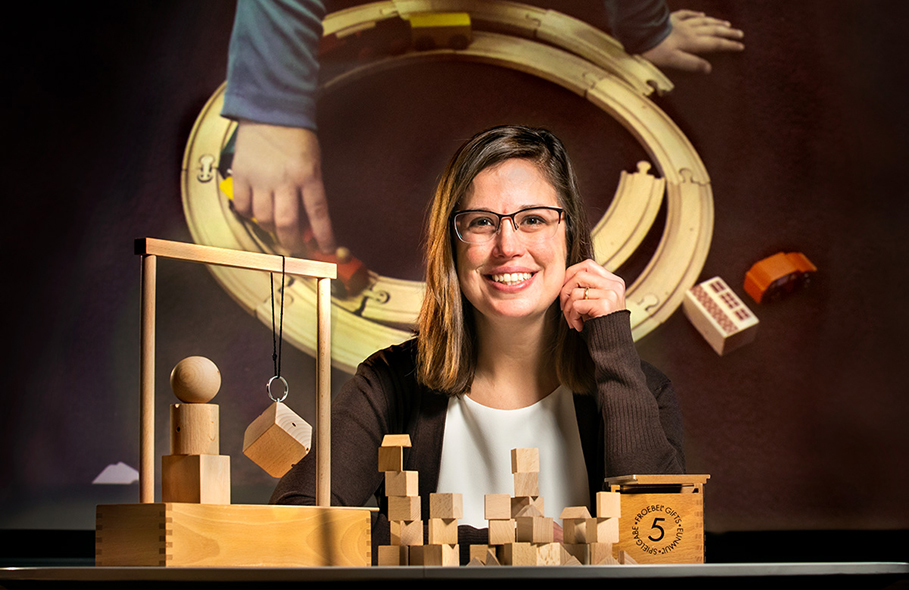Behind the Scenes Blog: Finding Time for Play
by Mary Lyons, Graduate Student, Curriculum & Instruction / Dec 5, 2019

photo by Fred Zwicky
Mary Lyons, Curriculum & Instruction graduate student, recently won 3rd place in the Graduate College's 2019 Research Live! competition. She shared more about her work in the UI News Bureau's 'Behind the Scenes' blog.
Before I step into the classroom, I hear children’s voices and feel the energy these five- and six-year-olds radiate. Once inside, I see bins of materials strewn about – a scene of organized chaos. The bins are full of toys, blocks, interactive cards, game pieces and other materials meant to develop the children’s fine motor skills and enhance their engagement with words and numbers. Some children cluster in pairs or threes, while others work on their own to solve puzzles, sequence symbols and explore.
I sit on the floor, a tablet computer in my lap. While the children appear to be unaffected by its presence, this tool is vital to my research. It allows me to snap photos, record audio and type my field notes without missing a moment of the action. More importantly, its covert functionality ensures that I am able to conduct my research without distracting the children from their work.
I am close enough to one group of children to hear their conversations, yet far enough away to take in the whole scene. I keep the teacher in view. I wonder, “How does she position herself in relation to the children? Who is she observing and interacting with today? How does she prompt the children and question them to enhance their learning?” It is my job to investigate her practice to better understand the strategies she uses to support the children’s play-based learning.I am keenly aware of a worrisome trend in classrooms like this one: They are devoting more time and attention to teaching academic content, thus reducing the time for play. Young children are susceptible to stress when pressured to perform on cue, yet academically oriented curricula often prescribe set sequences for learning. This is common in elementary classrooms.
Kindergarten belongs to both early childhood education and K-12 school systems, and this makes it vulnerable. Decisions at the district level often lump kindergarten in with upper elementary grades, forgetting that kindergarteners are in a unique developmental stage of their lives. In our current era of high-stakes testing and accountability, expectations about academic rigor are trickling down to affect our youngest learners. Even at my research site, where play is supported, such pressures exist.
While academics and play are not at odds with one another, and academic learning can in fact be abundantly playful, there is a distinction when it comes to children’s learning and development. Academic pressures are associated with stress in young children, while psychoanalytic theory describes play as an avenue that helps children learn how to manage and cope with stress.
I can see how this is true by watching the children play. One girl tells of losing a beloved pet, then spends her free time caring for a stuffed dog. She lies down with him, takes him for a walk, “feeds” him, plays with him and talks to him.
Another child pretends to prepare a meal in a kitchen area while also talking on a play telephone. “Stop yelling at me!” she says abruptly, then slams the phone down.
“My uncle was yelling on the phone, and I don’t want to talk to him anymore,” she says, to no one in particular.
Both girls are using play to cope with emotionally distressing events they have experienced or witnessed at home, and school provides a safe place for them to do so.
Research suggests that the downward trend in time for play, coupled with growing stressors, could have negative implications for children’s mental health and, in turn, their long-term outcomes.
The kindergartners trail out of the classroom to music class, and I check in with the teacher. I ask her about a recent staff meeting I attended, during which the kindergarten teachers pushed back against an initiative that would, again, increase the time spent on academics while reducing the time for play.
“I know that it is developmentally appropriate for children to play,” she tells me. “These are five- and six-year-old children, and most of their learning comes through play, where they can solve problems, engage in pretend play, manipulate materials and cooperate with peers, in addition to so much more. I will fight for time for play and continue to find ways to make the content we’re learning fun.”
This teacher is fighting a good fight. Through advocacy and determination, she makes a daily effort to enrich children’s early learning experiences. I hope that one day soon my research will help support more teachers like her.
View this story and more photos at the News Bureau website...